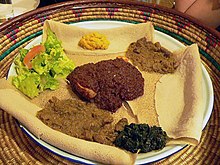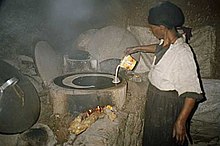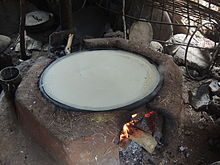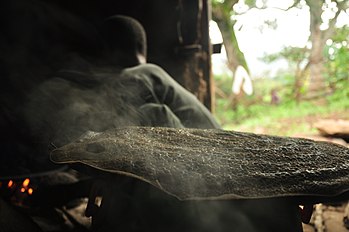Injera



The Injera ( Amharisch and Tigrinya : እንጀራ ənǧära [ ɨnd͡ʒǝra ]; also: Enjera, Injerra or Injira ) is a soft, leavened flatbread from Teff flour . It is traditionally eaten in Ethiopia and Eritrea . The flour is mixed with water to form a dough that has to ferment for a few days. Then soft flat cakes are baked from it on hot clay plates, which, like the French galette, can be easily broken up with your fingers. The surface contains many visible air pores, which makes Injera suitable for absorbing sauces.
Injera is related to the lahoh flatbread, which in Yemen , Somalia and Djibouti mainly from Sorghum is prepared and the kisra (Kissra) from sorghum or wheat, which in Sudan , South Sudan and in Chad is eaten. The North African Berber baghrir shop bread consists of durum wheat semolina and is usually consumed sweet. Injera also has a similar taste and texture to Indian appam .
Injera serves as a base and addition to many other dishes such as vegetable and meat ragout or is consumed with strongly seasoned pastes and sauces . You tear off pieces of injera with your right hand and use it to grab a bite-sized portion of the ragout or some seasoning paste. Injera is therefore both a dish and a plate.
Teff grows mainly in layers of medium altitude with a lot of rain. Depending on their color, teff seeds are used to make: nech (white), key or quey (red) or sergegna (mixed) injera . Since the yield is low, it is not a cheap raw material in Ethiopia and Eritrea either. Alternatively, sorghum is occasionally used. Farmers in the Ethiopian highlands who grow wheat , barley , maize or rice for their own use, also use these grains to produce injera.
Manufacturing
The sourdough fermentation can be accelerated by adding Ersho , a yellowish clear liquid that collects on the surface of the dough and is obtained and stored from previous sourdough batches . Ersho contains aerobic bacteria and various yeasts : Candida milleri , Rhodotorula mucilaginosa , Kluyveromyces marxianus , Pichia naganishii and Debaromyces hansenii .
The dough mixture is usually left to stand for two to three days until a mildly sour taste develops. The dough contains enough water that it can be poured onto the hot plate.
See also
Footnotes
- ↑ a b Minten Bart, Taffesse, Alemayehu Seyoum, Brown Petra: The economics of teff: Exploring Ethiopia's biggest cash crop ( en ). Intl Food Policy Res Inst, July 19, 2018, ISBN 9780896292833 .
- ↑ M. Ashenafi: Microbial flora and some chemical properties of ersho, a starter for teff (Eragrostis tef) fermentation . In: World Journal of Microbiology & Biotechnology . 10, 1994, pp. 69-73. doi : 10.1007 / BF00357567 . PMID 24420890 .



